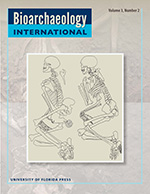Ambiguity in the Bioarchaeological Record: The Case of "Euthanasia" at Roonka, South Australia
Main Article Content
Abstract
In 1983, Pounder et al. described the burial of a woman and fetus as a probable case of mercy killing due to obstructed labor. In this article we reanalyze Burial 110 using multiple strands of evidence, including reconsideration of the trauma, reanalysis of the burial position and the age of the child, ethnohistoric and ethnographic evidence relating to violence and childbirth, historical and epidemiological data on maternal causes of death, and comparative bioarchaeological
analyses from Australia.
The woman was estimated to be between 30 and 40 years of age at the time of death with a fetus possibly 36–40 weeks in her abdominal cavity. While we support Pounder et al.’s (1983) interpretation of two injuries to the cranial vault, the woman’s burial position is ambiguous and probably not indicative of obstructed labor. Based on the comparative data, we argue that her injuries are more consistent with violence in late pregnancy than with mercy killing due to a difficult childbirth. However, this story is not uncomplicated. This woman was certainly killed, but what the burial itself demonstrates is how multifaceted violence and care can be. Our argument is that, in the desire to reconstruct past lives, bioarchaeologists need to give due weight to the ambiguities of reconstruction and the likelihood that the past was as complex as the present.
En 1983, Pounder et al, describieron el entierro de una mujer y su feto como un caso probable de muerte intencional por compasión debido a dificultades durante el parto. En este articulo analizamos Entierro 110 utilizando varias líneas de evidencia. Estas incluyen la reconsideración del trauma, reanálisis de la posición y edad del feto, evidencia etnohistórica y etnográfica en relación a la violencia y el parto, información histórica y data epidemiológica sobre causas de muerte maternal, y análisis bioarqueológicos comparativos provenientes de Australia.
La edad de la mujer se estima ser entre 30 y 40 años al momento de su muerte presentando dentro de su cavidad abdominal un feto de 36 a 40 semanas. Mientras concordamos con la interpretación de Pounder et al (1983) respecto a dos lesiones en el cráneo, su posición de entierro es ambigua y probablemente no indicativa de un parto obstruido. Basándonos en data comparativa, proponemos que sus lesiones son más consistentes con actos de violencia durante la etapa final del embarazo que originadas por muerte por compasión debido a un parto dificultoso. Aun así, esta historia no es sin complejidades. Esta mujer fue sin duda asesinada, pero las características del entierro demuestran el carácter multifacético de la violencia y el cuidado. Nuestro argumento es que, en el deseo de reconstruir vidas pasadas, los bioarqueólogos necesitan otorgar la debida importancia a las ambigüedades en la reconstrucción y aceptar la posibilidad que el pasado fue tan humano y complejo como lo es en la actualidad.

